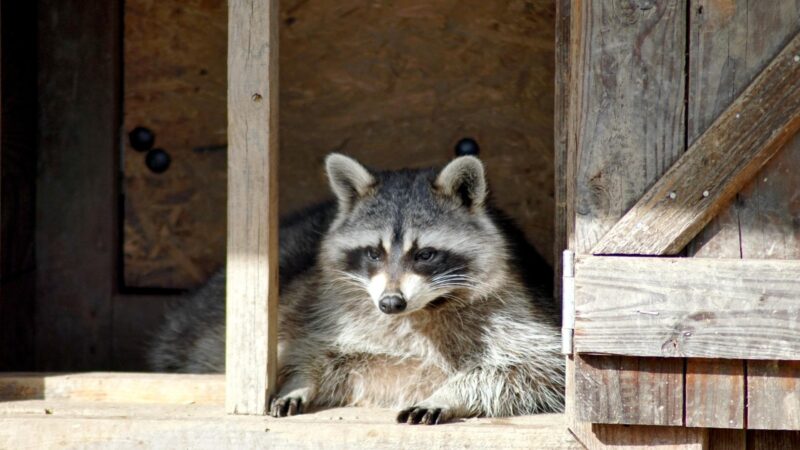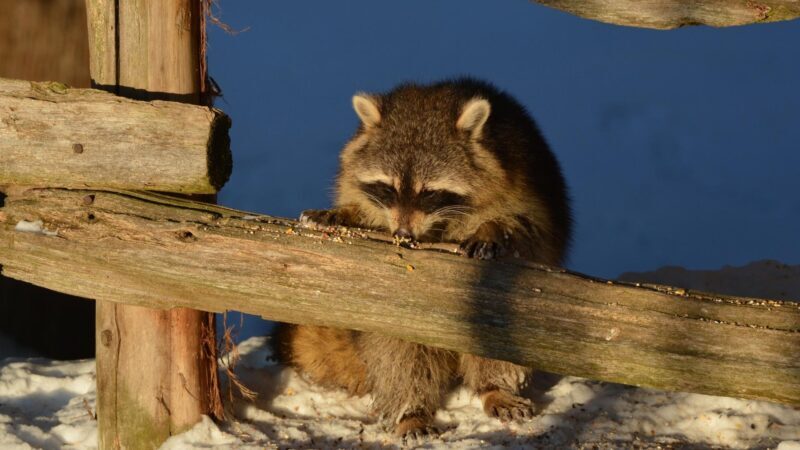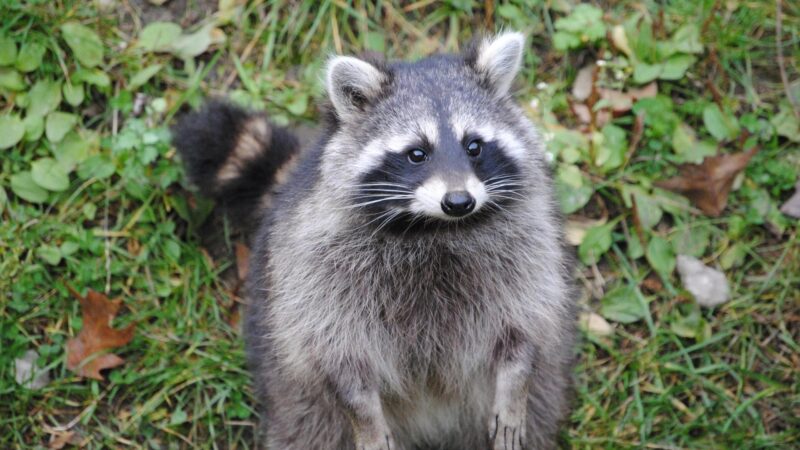Having raccoons in your attic can be a truly frustrating experience. They can tear roof decking and cause a fire hazard when damaging home wirings.
How to get rid of raccoons in the attic? There are many ways to get rid of raccoons, and some of them are the following:
- Trap—Most traps are wire cages with a trigger plate inside that closes when the raccoon goes in. Put bait within the trap, such as fresh fruit, canned tuna, or whole egg, to lure the raccoon into the trap.
- Loud Noises—This scares the raccoons away. You can use a battery-operated radio and put it in your attic to deter them from coming again.
In this guide, we’ll provide you with more ways to get rid of raccoons in your place, along with their indications and other removal tactics. So, let’s get started!
Table of Contents
Signs of Raccoons in the Attic

Though raccoons can be sneaky, there are a few signs to know if one is staying in your attic. These signs can help you evaluate whether you have a raccoon issue and where they are entering.
Some indications of an established presence of raccoons in the attic are:
- Chewing, scratching noises
- Dust footprints
- Droppings (tubular-shaped and usually dark in color)
- Foundation vents holes
- Defined trails via insulation in the attic
- Pawprints and scratch marks on woodwork
- Frequent sightings of raccoons in the yard or roof
- A random smudge of dirt outside your home
- Pulled apart or out of place soffit panels
Since a raccoon in the attic can expose your family to multiple health risks, such as ticks and parasites, it’s best to get rid of them right away using the given steps below.
Crucial Steps in Getting Raccoons Out of Your Attic
Getting rid of raccoons is essential because of the diseases they carry, such as rabies, salmonella, and leptospirosis. You may follow the given steps below to eliminate raccoons in your attic successfully.
Step 1: Listen and Look for all the Raccoons in Your Attic
The primary reason a raccoon made your attic a new den is that the female is close to giving birth. Raccoons need a dry, warm and safe place to raise their young, and your attic makes an ideal spot.
Baby raccoons are typically born in early spring between March and April. So, most homeowners usually experience raccoon invasion as early as February to May.
Listen for the tiny, scratching sounds to find the pups. However, this can be a daunting job as there’s no guarantee that you’ll find them right away.
The mother usually hides them in the eaves, down a wall, or other unreachable locations. You have to get into the attic, push your way through raccoon excretions and check every hidden spot.
Make sure to wear protective clothing and be careful against the angry raccoon attack. Once you’ve located the raccoons, it’s time to move on to the next step.
Step 2: Inspect Your Home for Entry Holes
So, you’ve already located the raccoons and their pups in their hidden spot. The next thing you need to do is inspect your home for entry holes to know the parts that you need to cover or repair after you’ve removed them from your place.
In some circumstances, raccoons residing in or around your house could be raising young. So, don’t cover up any entry points while the raccoons are still within. Otherwise, they’ll get trapped.
Baby raccoons need at least several weeks before they’re firm enough to go outside. Hence, you may have to wait this long to block the access holes permanently.
If you choose not to wait, call a professional wildlife control expert in holding raccoon families jointly for relocation. Some of these experts use one-way doors, allowing raccoons to be out but not back in.
After the relocation, look for the entry point and fix it after removing the infestation. Look for any damage, making a list of all the necessary materials to fix it.
Step 3: Remove Raccoons by Trapping
There are several methods to remove raccoons, but not all are humane. Trapping is the only compassionate and safe way to do that.
Before removal, wear thick leather gloves, vacate all the baby raccoons, and gently place them in a pillowcase. Don’t be tricked by their innocent looks—young raccoons can claw and bite, so be careful.
Once you’ve removed the baby raccoons, it’s now time to set the trap. If you don’t have a trap yet, you can get one from your local hardware store or get it delivered right to your door when you order online.
To target the raccoon successfully, use the pups as live bait. A mother raccoon is very caring and protective of their young and does whatever it takes to rescue the pups.
Put the pups in the back of the cage, and the mother will rescue the young raccoons at any cost. If you think you can’t do this, you can always call a wildlife professional to do this job for you.
It’s also best to check the local laws to see if you’re legally allowed to do your own trapping.
Step 4: Try Other Removal Tactics
Another way to remove a raccoon in the attic is to play loud music occasionally. This makes them want to leave the area forcefully and find a quiet place to live and raise their young pups.
You can also leave an irritating odor within the attic, such as peppermint essential oil. All you have to do is get a clean spray bottle, fill it with at least half water and drop some peppermint oil there.
After that, lightly shake the spray bottle to mix the two ingredients thoroughly and start spraying all the areas of your attic.
Step 5: Clean Up and Decontaminate
Once you’ve taken the raccoons out of your attic, the next step will be cleaning up and decontaminating the area. Raccoons are messy and use attic their latrine.
Their urine and feces may be stocked in one area or scattered everywhere — either way, it’s not a pleasant sight or smell. Aside from being gross, raccoon droppings are detrimental to your health and pets, not to mention they can potentially cause mites and flea infestations.
Once the droppings are removed, repair and restoration work should be considered the next step.
Step 6: Repair Attic Damage
Finally, after the raccoons have been moved and the area is clean, fix the attic to ensure the raccoons won’t have any access to your attic again. Repair roof entry holes and any other damage they have generated in your attic.
What Damage Can Raccoons Do?

Raccoons cause extensive damage to critical parts of your home, such as soffit or roof. Roof damage forms an opening allowing water in and causing mold.
Their claws can also easily tear through the fascia, roof decking, shingles, and soffit. Raccoons can also destroy the wooden structures and the Heating, Ventilation, and Air Conditioning (HVAC) ducts.
Once they damage wiring, it can create a fire hazard that can potentially harm your family and property on a large scale. In addition, a raccoon in the attic can also put your family at risk in terms of health.
Their droppings carry roundworms, other parasites, and many types of diseases, such as rabies, a contagious infection that can affect humans. This can cause partial paralysis, confusion, agitation, etc.
Do Racoons Cause Damage to Homes?
Raccoons can cause structural damage to your home. Aside from insulation, raccoons often damage electrical systems and ventilation running through the attics.
Without doing electrical repair, which costs around $280 on average, these damages can lead to fire and water damage, along with molds.
Piles of droppings also build spores soaked into broken ducts and penetrate your living space, which can quickly cause systemic disease when inhaled.
Is It Bad to Have Raccoons in Your Yard?

Having raccoons in your yard is truly bad as they can damage your property and are potentially harmful when encountered.
Hence, if you’ve seen some raccoons in your yard recently, contact a pest control company that’s known for dealing with raccoon removal.
What Do Raccoons Hate the Most?

Raccoons possess a strong sense of smell, which they often use to locate food sources. So, as a homeowner pestered by these creatures, you can take advantage of this trait by using the aromas they despise.
For instance, you can use garlic, peppermint oil, hot pepper, onion, and Epsom salt to repel these raccoons. To use garlic:
Step 1: Mince at least 3 ounces of garlic. Mix it with 2 tablespoons of mineral oil.
Step 2: Seal the mixture for 24 hours in a glass container and let it soak.
Step 3: After 24 hours, get a clean spray bottle, fill it with a pint of water and add an ounce of dishwashing liquid with 2 tbsp of the oil and garlic mixture.
Step 4: Once done, spray the mixture around your yard and reapply after two to three days from application.
What Is a Good Raccoon Repellent?
A good raccoon repellent works well in irritating the raccoon’s senses to keep them at bay. Some of the good examples of this are the following:
Peppermint Essential Oil
Peppermint essential oil works best in keeping raccoons away from your property due to its strong scent. To use:
- Get a clean spray bottle. Put 2 ounces of rubbing alcohol into it. Then, add another 2 ounces of peppermint essential oil.
- Once done, fill the rest of the bottle’s space with water and spray the solution around the areas where you’ve noticed raccoon activities.
Coffee Grounds
Another thing disliked by raccoons is coffee grounds due to their scent and natural acidity, making them an effective repellent. To use:
- Sprinkle coffee grounds into the affected areas. Reapply as needed.
Cayenne Pepper and Chili Flakes
Cayenne pepper and chili flakes are excellent raccoon deterrents. These spices have a strong odor that this masked bandit finds extremely unpleasant to smell.
Both the spices’ taste and smell will make the raccoon rush away. The two condiments also work as an irritant, making raccoons consider not coming back.
To use:
- Sprinkle the two spices in your yard or any affected areas.
- You can also make a spray solution from cayenne pepper by mixing it with water and adding some drops of hot sauce.
- Once done, spray the solution to your yard and surrounding areas where raccoon activities are frequent to ward them off from your property.
Epsom Salt
Epsom salt is another item that you can use against raccoons. Both the scent and the feel of Epson salt deter the raccoons away.
To use:
- Grab a generous amount of Epson salt and sprinkle it in the areas where you usually observe raccoons. Don’t forget to reapply after the rain as its odor wears off quickly.
Predator Urine
Another effective raccoon repellent you can use to scare these masked creatures is predator urine. This urine is from various predators, such as coyotes, foxes, wolves, lions. etc.
You can buy them in your local pet store or online. The scent triggers the fear of raccoons and thinks that a predator is within the area, scaring them away from your yard.
To use:
- Pour the urine in the surrounding areas where raccoons frequently visit.
Their sharp sense of smell will alert them, making them flee from the site.
Vinegar
Another inexpensive yet effective household product raccoons can’t stand the pungent scent of vinegar. It irritates them, and as a result, they stay away whenever they sense its smell.
To use:
- Soak a rag with vinegar and hang it on a tree or pole in the site you want to repel raccoons. This will be strong enough to deter raccoons from coming into your area.
Will Vinegar Keep Raccoons Away?
Vinegar is one of the household items that raccoons hate. So, if you’ve noticed any activities of these creatures, get apple cider vinegar from your kitchen, soak a cloth on it, and put it in an aerated container close to their den.
Do Raccoons Hate the Smell of Bleach?
Raccoons despise the strong scent of the bleach as it affects their sense of smell used in locating their food sources.
Frequently Asked Questions
Do Raccoons Leave the Attic during the Day?
Raccoons are nocturnal creatures. However, you may see a mother raccoon leaving the attic during the day to search for food to feed its young.
How Long Does It Take To Remove Raccoons from Attic?
According to a wildlife company, it’ll take approximately 8 to 10 weeks to remove raccoons from the attic, as the mother will be with the kits until they’re strong enough to go out.
How Do You Encourage Raccoons to Leave?
To urge raccoons to leave with their young from your house, you can put a battery-operated radio in the attic and play a piece of loud music. You can also put a bright light in their den to cause a disturbance.
Raccoons both hate being in a bright place as they are nocturnal and detest loud sounds. So, if you do these things, you’re encouraging these animals to leave your vicinity.
Can Raccoons Break through Ceiling?
Raccoons have small ‘hands’ and can grab and lift the tiles if they want to. However, this mostly depends on the workmanship of your ceiling.
If your ceiling is wearing out, there’s a high probability that a raccoon can break into it. Nonetheless, if your ceiling is still in great condition and quality, it’s unlikely for a raccoon to break through it.
How Do Professionals Get Rid of Raccoons?
Professionals get rid of raccoons in the most humane way possible. This means they do raccoon removal without hurting the animals using live bait.
They also remove all the nesting material in the area where raccoons used to live and clean, as well as decontaminate the site before leaving your property.
How Much Does It Cost to Remove Raccoons from Attic?
On average, a raccoon pest control fee ranges from $300 to $550, with most homeowners spending $450 to set the traps, do raccoon relocation, clean up the site, and fix the affected spot on your property.
Does Homeowners Insurance Cover Damage from Raccoons?
A standard homeowners insurance usually covers the attic, roof, or other home structure damages. However, repair or replacement of personal items like clothing, furniture, and electronics aren’t typically included in the said insurance.
What Time of Night Are Raccoons Most Active?
Raccoons are particularly active from dusk to dawn. As nocturnal animals, they mostly spend their day sleeping in tree hollows, crawlspaces, barns, and abandoned cars.
Summary
Raccoons can be a menace to your property, so consider using the guide above to get rid of these nuisances from your home. In case you’re not up to the task or too busy to handle this chore, you can always hire a local professional pest control company to do the job for you.
List of Sources
Best Management Practices – Trapping Raccoons in the United States